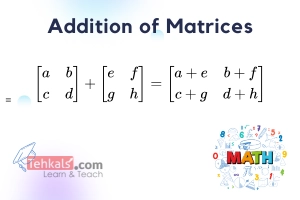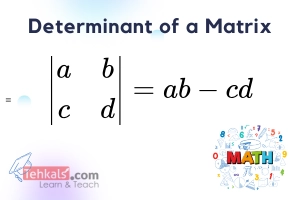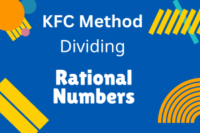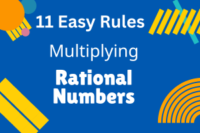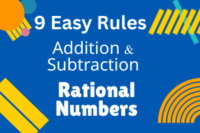Multiplication of Matrices
Published: 11 Mar 2023
In this blog post, you will find how to Multiply matrices step by step with examples and MCQs to help you to understand the concept. Whether you are new to matrices or need a refresher, this post is perfect.
After covering this, you will be able to learn about the basic concepts related to the Multiplication of matrices and other related ideas related to Matrix Multiplication.
Multiplication of Matrices – Definition and Concept
For the Multiplication of Matrices, it shall be noted that the number of columns of the first matrix equals the number of rows of the second matrix. Otherwise, the multiplication of matrices is not possible.
Multiplication of Matrices explained
$ A=\left[\begin{array}{l}a \\ b\end{array}\right], B=\left[\begin{array}{ll}p & q\end{array}\right], $
$ C=\left[\begin{array}{cc}1 & -1 \\ -2 & 1\end{array}\right] D=\left[\begin{array}{lll}p & r & s\end{array}\right] $
1. AB
As the number of Columns in the matrix $ A=1 $
And the number of Rows in the matrix $ B=1 $
Thus, the multiplication of AB is possible.
2. AC
As the number of Columns in the matrix $ A=1 $
And the number of Rows in the matrix $ C=2 $
Thus, the multiplication of AC is not possible.
3. AD
As the number of Columns in the matrix $ A=1 $
And the number of Rows in the matrix $ D=1 $
Thus, the multiplication of AD is possible.
4. BA
As the number of Columns in the matrix $ B=2 $
And the number of Rows in the matrix $ A=2 $
Thus, the multiplication of BA is possible.
5. BC
As the number of Columns in the matrix $ B=2 $
And the number of Rows in the matrix $ C=2 $
Thus, the multiplication of BC is possible.
6. BD
As the number of Columns in the matrix $ B=2 $
And the number of Rows in the matrix $ D=1 $
Thus, the multiplication of BD is not possible.
7. CA
As the number of Columns in the matrix $ C=2 $
And the number of Rows in the matrix $ A=2 $
Thus, the multiplication of CA is possible.
8. CB
As the number of Columns in the matrix $ C=2 $
And the number of Rows in the matrix $ B=1 $
Thus, the multiplication of CB is not possible.
9. CD
As the number of Columns in the matrix $ C=2 $
And the number of Rows in the matrix $ D=1 $
Thus, the multiplication of CD is not possible.
10. DA
As the number of Columns in the matrix $ D=3 $
And the number of Rows in the matrix $ A=2 $
Thus, the multiplication of DA is not possible.
11. DB
As the number of Columns in the matrix $ D=3 $
And the number of Rows in the matrix $ B=1 $
Thus, the multiplication of DB is not possible.
12. DC
As the number of Columns in the matrix $ D=3 $
And the number of Rows in the matrix $ C=2 $
Thus, the multiplication of DC is not possible.
Multiplication of Matrices
(i). Is it possible to find AB?
(ii). Is it possible to find BA?
(iii). Find the possible products/ products.
Solution:
Step 1: Multiplication of Matrices Possibility
Ensure that the Number of Columns in the first matrix equals the Number of Rows in the second matrix.
(i). AB
As the number of Columns in the matrix $ A=2 $
And the number of Rows in the matrix $ B=2 $
Thus A B is possible for multiplication.
(ii). BA
As the number of Columns in the matrix $ B=1 $
And the number of Rows in the matrix $ A=2 $
Thus BA is not possible for multiplication.
Now we find the multiplication of matrices AB .
Step 2: Write down the matrices
$ A B=\left[\begin{array}{cc} -1 & 0 \\ 2 & 1 \end{array}\right]\left[\begin{array}{c} 3 \\ -2 \end{array}\right] \\ $
Step 3: Multiply the Corresponding Elements
Multiply the first row of matrix A with each corresponding element of the first column of matrix B and then add these products.
OR
For multiplication, multiply each element of a row of the first matrix by the corresponding element of the column of the second matrix and then add these products.
$ AB =\left[\begin{array}{c} (-1)(3)+(0)(-2) \\ (2)(3)+(1)(-2) \end{array}\right] \\ $
$ =\left[\begin{array}{c} -3+0 \\ 6+(-2) \end{array}\right] \\ $
$ =\left[\begin{array}{c} -3 \\ 6-2 \end{array}\right] \\ $
$ =\left[\begin{array}{c} -3 \\ 4 \end{array}\right] $
MCQs on Matrix Multiplication
1. When number of columns of First matrix equal to number of rows of Second matrix is ________ for multiplication.O Conformable
O Not conformable
O Both a & b
O None of these
Show Answer
Conformable
Explanation:
Rules for Multiplication
2. If A is $ m \times p \ \& \ B \ is \ p \times n $ then AB is ________ for multiplication.
O Conformable
O Not conformable
O Both a & b
O None of these.
Show Answer
Conformable
Explanation:
This shows that A and B are conformable for multiplication because number of columns of first matrix equal to number of rows of second matrix. In short $ p=p $
3. If the order of $ A \ is \ m \times p \ \& \ B \ is \ p \times n $ then the order of $ AB $ is ________
O $ m \times p $
O $ p \times m $
O $ m \times n $
O $ p \times n $
Show Answer
$ m \times n $
Explanation:
This shows the order of product AB. Thus
$ A_{m \times p} \times B_{p \times n}=AB_{m \times n} $
4. If $ A \ is \ p \times n \ \& \ B \ is \ m \times p $ , then AB is ________ for multiplication.
O Conformable
O Not conformable
O Both a & b
O None of these.
Show Answer
Not Conformable
Explanation:
Here No. of rows of first matrix equal to number of columns of second matrix. Thus it is not conformable for multiplication.
5. If $ A=\left[\begin{array}{ll}2 & 3 \\ 1 & 4\end{array}\right], B=\left[\begin{array}{l}3 \\ 5\end{array}\right] $ , then AB is ________
O Possible
O Not possible
O None of these
Show Answer
Possible
Explanation:
Here number of columns of A matrix equal to number of rows of B matrix. Thus, multiplication is possible.
6. If $ A=\left[\begin{array}{l}3 \\ 2\end{array}\right], B=\left[\begin{array}{l}1 \\ 2\end{array}\right] $ then multiplication of matrices are ________
O Possible
O Not possible
O Correct
O None
Show Answer
Not possible
Explanation:
Here number of columns of A matrix not equal to number of rows of B matrix. Thus, multiplication is not possible.
7. Commutative law of multiplication of matrices may be ________
O $ A B=B A $
O $ A B \neq B A $
O Both a & b
O None of these
Show Answer
Both a & b
Explanation:
In multiplication of matrices, Sometime Commutative law is possible but mostly not possible.
See Example 10 and 11 in KPK book Page No. 23
8. $ A(BC)=(AB) C $ is called ________ law of multiplication.
O Commutative
O Associative
O Distributive
O None of these
Show Answer
Associative
9. Identity matrix is also known as ________ identity.
O Additive
O Multiplicative
O All of these
O None of these
Show Answer
Multiplicative
Explanation:
When Identity matrix is multiplied to any matrix, the answer will be that matrix.
10. $ (A+B)C=AC+AB $ is called ________ law of multiplication over addition.
O Commutative
O Associative
O Distributive
O None of these
Show Answer
Distributive
11. $ A I=I A= $ ________
O A
O Null
O None
Show Answer
A
Explanation:
When Identity matrix “I” is multiplied to matrix “A”, the answer will be that matrix.
12. $ B I= $ ________
O A
O B
O I
O None
Show Answer
B
Explanation:
When Identity matrix “I” is multiplied to matrix “B”, the answer will be that matrix.
13. Multiplicative identity of $ A=\left[\begin{array}{ll}1 & 3 \\ 4 & 5\end{array}\right] $ is ________
O $ \left[\begin{array}{ll}1 & 4 \\ 3 & 5\end{array}\right] $
O $ \left[\begin{array}{ll}1 & 4 \\ 3 & 5\end{array}\right] $
O $ \left[\begin{array}{ll}-1 & -3 \\ -4 & -5\end{array}\right] $
O $ \left[\begin{array}{ll}1 & 0 \\ 0 & 1\end{array}\right] $
Show Answer
$ \left[\begin{array}{ll}1 & 0 \\ 0 & 1\end{array}\right] $
Explanation:
The multiplicative identity for every matrix is:
$ \left[\begin{array}{ll}1 & 0 \\ 0 & 1\end{array}\right] $
14. If $ A=\left[\begin{array}{lll}1 & 2 & 3 \\ 4 & 5 & 6\end{array}\right] \ and \ I=\left[\begin{array}{ll}1 & 0 \\ 0 & 1\end{array}\right] \ then \ AI= $ ________
O A
O I
O AI
O Not possible
Show Answer
Not possible
Explanation:
Here number of columns of A matrix not equal to number of rows of I matrix. Thus, multiplication is not possible.
15. Transpose of $ \left[\begin{array}{ll}1 & 3 \\ 4 & 5\end{array}\right] $ is ________
O $ \left[\begin{array}{ll}1 & 4 \\ 3 & 5\end{array}\right] $
O $ \left[\begin{array}{ll}1 & 6 \\ 5 & 7\end{array}\right] $
O $ \left[\begin{array}{ll}1 & 0 \\ 0 & 1\end{array}\right] $
O All of these
Show Answer
$ \left[\begin{array}{ll}1 & 4 \\ 3 & 5\end{array}\right] $
Explanation:
In transpoes, we interchanged the rows and columns.
16. $ \left(A^t\right)^t= $ ________
O A
O $ A^2 $
O All of these
Show Answer
A
Explanation:
If we take the transpose of a matrix and then again took the transpose, as a result the answer will be that matrix.
17. $ \left(c^t\right)^t= $ ________
O $ c^t $
O $ -c $
O I
O C
Show Answer
C
Explanation:
If we take the transpose of a matrix and then again took the transpose, as a result the answer will be that matrix.
18. $ (A B)^t= $ ________
O $ A^t B^t $
O $ B^t A^t $
O $ (B A)^t $
O None of these
Show Answer
$ B^t A^t $
Explanation:
The transpose of the product of the matrices is equal to the product of their transposes but in the reverse order.
19. $ (B A)^t= $ ________
O $ A^t B^t $
O $ B^t A^t $
O $ (A B)^t $
O None of these
Show Answer
$ A^t B^t $
Explanation:
The transpose of the product of the matrices is equal to the product of their transposes but in the reverse order.
20. $ (A+B)^t= $ ________
O $ A^t+B^t $
O $ A^t-B^t $
O $ (A B)^t $
O $ A^t B^t $
Show Answer
$ A^t+B^t $
Explanation:
21 . $ (A-B)^t= $ ________
O $ A^t+B^t $
O $ A^t-B^t $
O $ (A B)^t $
O $ A^t B^t $
Show Answer
$ A^t-B^t $
Explanation:

- Be Respectful
- Stay Relevant
- Stay Positive
- True Feedback
- Encourage Discussion
- Avoid Spamming
- No Fake News
- Don't Copy-Paste
- No Personal Attacks



- Be Respectful
- Stay Relevant
- Stay Positive
- True Feedback
- Encourage Discussion
- Avoid Spamming
- No Fake News
- Don't Copy-Paste
- No Personal Attacks
